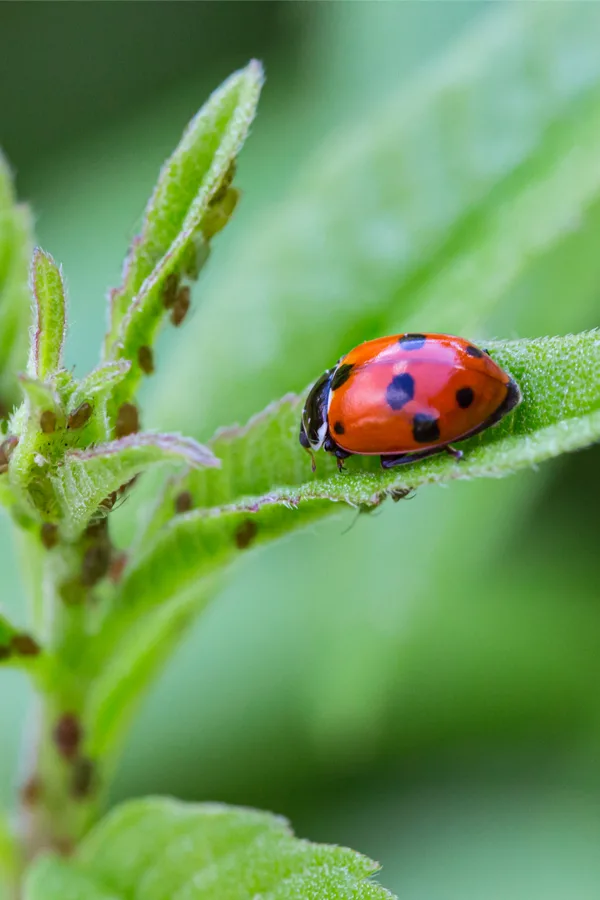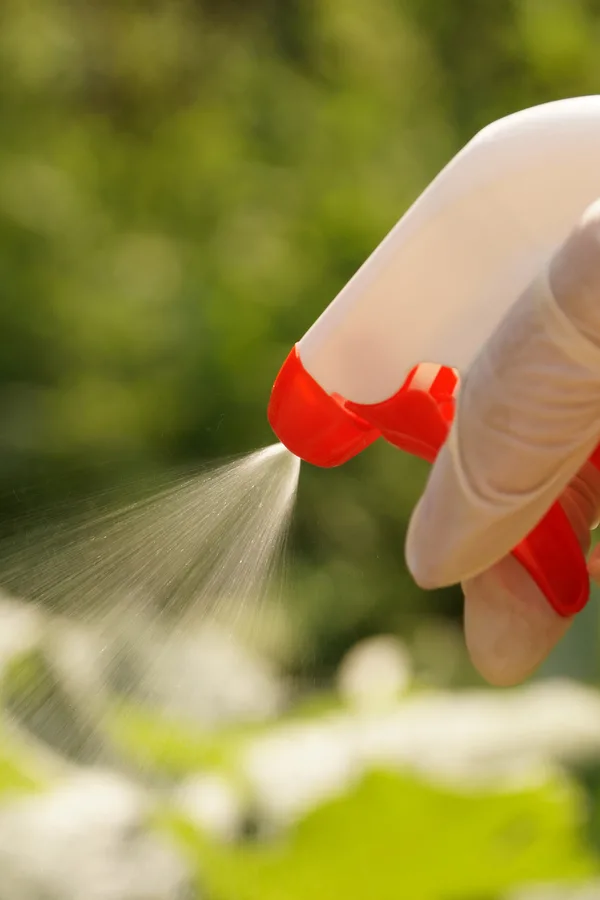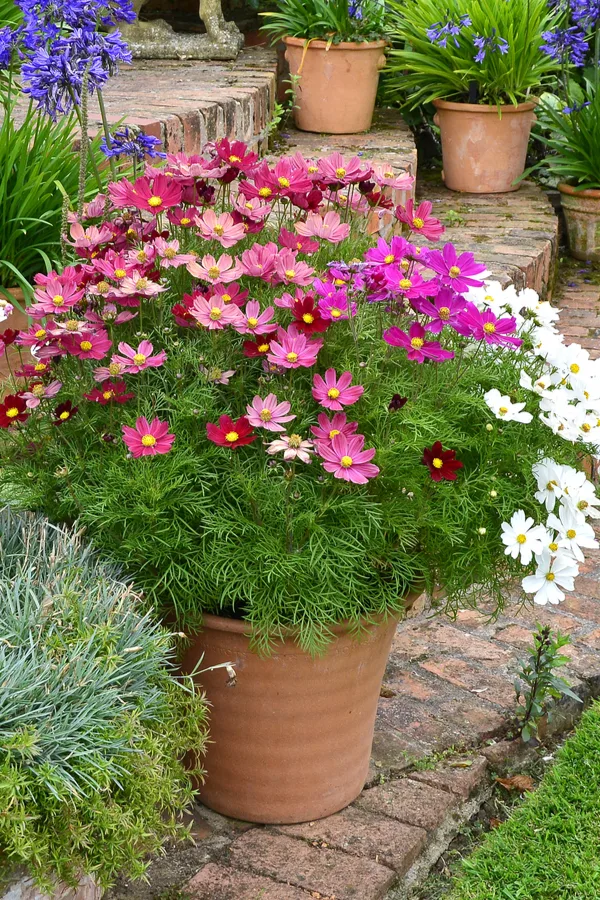There is no better way to control pest problems naturally in your garden, flowerbeds and landscape than by attracting ladybugs to your outdoor spaces!
Ladybugs are one of the most efficient methods for pest control around. Not only do they consume thousands upon thousands of insects in their lifetime, they also feed on the larva of insects, preventing the next wave of damage as well.
As for the pests they help to control, the list is long. But at the top of the ladybug’s “favorites” list is the dreaded aphid. And controlling aphid populations is certainly a plus for any gardener.

Aphids feed on the the sap within the stems and leaves of both vegetable plants and flowers. Left unchecked, their population can swell in just days. When that happens, it can spell the end of the line for plants. Especially younger tender garden vegetable plants and annuals!
Ladybugs To The Rescue…
But with a small army of ladybugs on the job, aphids have trouble establishing enough of a presence to cause any real harm. And ladybugs don’t stop with just aphids, they also love to forage for mites, mealy bugs, leafhoppers and a whole host of other insects.
With all of that insect control power, it’s easy to see why attracting them to your landscape can have big rewards. With that in mind, here is a look at a few key tips to getting ladybugs to take up full time residence in your backyard!
How To Attract Ladybugs To Your Garden, Flowerbeds & Yard
Stop Spraying Bug Killers
First and foremost, the use of pesticides not only kills the ladybugs you are trying to attract, it also kills off all of their food sources.

The simple fact is, most pest populations are kept in check by the natural balance that nature provides. Unfortunately, pesticides do not discriminate between good bugs and bad bugs. And even worse, when applied, they can wipe out the pollinators you need right along with the pests causing the issue.
Ladybugs, along with honey bees, butterflies and all insects are important to your garden and flowerbeds. They help to pollinate plants, and without them there would be little vegetables, flowers or fruit. See: How To Attract Pollinators To Your Yard
Even pests like aphids and mites are important in their regular numbers. Why? Because they provide food for great pests like the ladybug. So if you want to have good insects around, eliminating the use of pesticides is the first thing you need to do.
Grow The Plants Ladybugs Love – How To Attract Ladybugs
Ladybugs love both insects and pollen. In fact, together, they are the main two staples of their diet. And as it just so happens, growing the plants they love to visit can give them both!
When it comes to flowers, ladybugs are extremely partial to cosmos, calendula and marigolds. These three annuals attract ladybugs in large numbers, and planting them in your flowerbeds and gardens can play a major role in keeping ladybugs around and pests under control.
Ladybugs also love a wide range of perennial flowers and herbs too. Sweet Alyssum, Coneflower, Dill, Cilantro and Chives are all favorites of the ladybug.

But it is in the vegetable garden where ladybugs usually find their home. Ladybugs love to visit common pest-prone plants such as cabbage, cucumbers, peppers and tomatoes. It is here that they can find a steady supply of the pest they love to eat. And in the process, of course, help keep them safe!
Provide Moisture
Ladybugs, just like every living creature, need water to survive. Ladybugs “drink” by lapping up the dew and moisture on plants, or in small puddles or pools of water.
It you happen to live an area with heavy morning or evening dew, conditions are most likely perfect for attracting ladybugs.

If you live in a more arid and dry climate, you may need to provide additional water and moisture. Spraying the foliage of plants in the early morning can help, as can making sure your plants and garden beds are covered in mulch.
Mulch helps to keep moisture trapped in the soil below, which is one of the reasons it is so vital for plant life. But it also helps insects like aphids. Not only can they seek shelter in the mulch, they can also absorb moisture within it as a source of water.
Other sources of water such as bird baths and fountains can play a role in helping aphids as well. As always, with these sources of water, be sure not to keep the water standing for long periods of time. Unfortunately, that will attract mosquito larvae, which ladybugs do not eat!
Creating A Ladybug House – How To Attract Ladybugs
With a bit of attention to the steps above, you can usually create a habitat where ladybugs love not only to visit, but call it home. With that said though, some gardeners like to take the extra step of creating a ladybug house to provide an actual place for them to reside.
Building your own ladybug house is actually a very simple and easy project. In fact, it is a great project if you have young children or grandchildren. It can teach them both about insects, and DIY’ing too!

The best material to use for a ladybug house is wood. Wood naturally holds moisture, which of course is beneficial to ladybugs. You can build your house in any shape, as ladybugs are not partial to size or the aesthetics.
For those that are not partial to the DIY approach, you can find a wide range of ladybug houses online. Product Link: Lulu Home Wooden Insect & Ladybug House
Keeping It Simple
The real key is to create a solid back, with open tubes or slots in the front. This will give the ladybugs plenty of shelter inside. Once built, hang the house in a tree or in a shrub off of the ground – and that’s it! No need to provide food or water, it’s the shelter they will appreciate more than anything.
Here is to attracting ladybugs to your landscape, and to keeping your pests under control naturally!
Follow Our Facebook Page For Great Gardening Tips And Advice! This Is My Garden Facebook Page
This Is My Garden is a garden website created by gardeners, for gardeners. Jim and Mary Competti have been writing gardening, DIY and recipe articles and books and speaking for over 15 years from their 46 acre Ohio farm. They publish three articles every week, 52 weeks a year. Sign up today to follow via email, or follow along!

